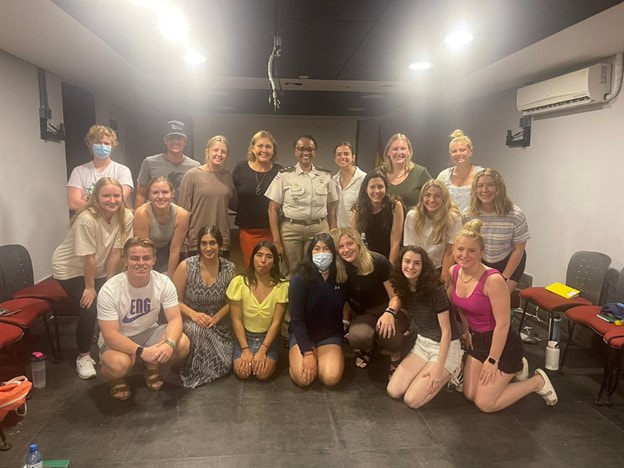|
By Ellie Nielsen & Morgan Ebel Before coming to Brazil, the class completed research projects in different areas. Ours happened to be violence against minorities and the one we decided to focus on was violence against women. Women make up over half of Brazil’s population. Yet they face extreme violence day in and day out. In the nation it is estimated that one woman was affected by violence every four minutes in 2017 and an average of 13 women were murdered each day (Araujo 2021, 123). That was just in 2017. It is a trend in Brazil that violence altogether is very high, especially, through and since the pandemic. More specifically violence against women is continuing to rise as well. In a study published in 2016, researchers broke up their study into two periods 2007-2009 and 2011-2013. 58 municipalities in Brazil partook in the research. They found that between the two periods of time there was an overall 10 percent increase of female deaths by aggression (Ceccon 2016, 2965). Each year since, there has been an expected increase of femicide. Femicide is a concept that was first described by Diana Russel as being a murder of a woman due to the victim being a woman. Russel further accounted femicide to being an act of sexual terrorism on top of it working as a mechanism for keeping women under control (Ceccon 2016, 2964). To say the least, knowing these statistics, traveling to this new country, and Pedro getting robbed the first night was quite a terrifying experience for the females on this trip. The first topic to understand is how gender norms and masculinity play a role in the continual increase of violence against women. Another large facet that is laid out in this research is the relationship between one’s race and gender. Lastly, we will touch on the lecture given to us by Major Denice Santiago from the Ronda Maria da Penha organization. Gender norms and toxic masculinity are leading causes of increased violence against women. A study was conducted to examine whether women delegated police stations in Salvador, Bahia created a more just system for women. The work looked at gender bias within the police force and found that its environment was more welcoming to women when run by women. The women in these systems were better fit to understand other female perspectives whereas men often felt the need to assert dominance and power. Prime aspects of the police system culture include hierarchal logic where positive value is associated with strong-arm versions of masculinity and negative value is associated with weakness and impotence in femininity (Hatzinger 2002, 146). Another study focused on the relationship between female morality and socioeconomic and demographic status in capital cities. This research found that women that acquire sexual and economic autonomy put themselves at greater risk of femicide as they place themselves against situations of subordination (Ceccon 2016, 2967). On the topic of race, black women in Brazil are two times more likely to face the risk of dying compared to white women (Ceccon 2016, 2965). Studies show that between 60 percent to 70 percent of murders committed against women are chalked up to be femicide and a nerving number of those femicides are young, poor, members of different ethnic minorities, migrants, or sex workers (Ceccon 2016, 2964). It is obvious that women within these minority groups are at an even greater risk of femicide. Major Santiago first brought our attention to the many challenges women face in Brazil. Women deal with issues regarding wages, social equality, femicide, violence, and much more. Major Santiago brought us the statistic that in Brazil, women between the ages 25 to 44 years old, 21.5% more women finish high school, but earn 23.5% less than men. Further, women only make up 10% of CEOs in the country (Santiago, 2022). From this we can already tell that, in the larger society, women are held to different standards than men and are severely discriminated against. These are similar circumstances to those in the United States therefore, we can relate on some level. However, what we cannot be blind to is the alarming rates, as made clear above, women face violence in Brazil. It is because of these outstanding numbers that Ronda Maria da Penha was founded on March 8, 2015, on international women’s day and named after 11.340/06 Law Maria da Penha. Maria da Penha is a real woman whose husband tried to kill her, twice! Before this law was passed, when a wife would report an incident of violence, the husband would only get community service (Santiago, 2022). This law brought forward five types of violence – physical, moral, sexual, property or possession, and psychological. This is important to put forward in order to educate the public on domestic violence and abuse – which is one of the organization's goals. Along with the main cause being to protect women after they press charges against their partners. In the 7 years that Ronda Maria da Penha has been fighting this battle, all 4,000 women that have been protected by the organization have never faced violence again (Santiago, 2022). All in all, this institution has reached a massive number of people, yet Major Santiago reminds us that the society has a long way to go in regard to violence against women. It is easy to see that there are serious issues surrounding violence against women in Brazil, and ones that have caused extremely unsafe environments for all women. Major Santiago touched on the inequality all women in Brazil face. However, we see that women of color are even more likely to fall victim to violence. We also acknowledge that many of these issues are often caused by toxic masculinity and the need for power and dominance. While there are some reforms happening, Brazil must continue to fight against these violence's to lessen its tolls. The relationship between race and gender is essential to continue learning about in the wake of this catastrophic violence epidemic. Bibliography Araujo, Victor, and Malu A. C. Gatto. 2022. “Can Conservatism Make Women More Vulnerable to Violence?” Comparative Political Studies 55, no. 1: 122-153. Ceccon, Roger Flores, Ian Meneghel Danilevicz, Vania Naomi Hirakata, Stela Nazareth Meneghel, and Bruna Alexandra Rocha da Rosa. 2016. “Femicides: a study in Brazilian state capital cities and large municipalities.” Ciencia & saude coletiva 22, no. 9 (January): 2963-2970. Hatzinger, Sarah. 2002. “Criminalizing Male Violence in Brazil’s Women’s Police Stations: From Flawed Essentialism to Imagined Communities.” Journal of Gender Studies 11, no 3: 243-251. Santiago, Denice. “Challenges of Women in Brazil.” Class lecture at Institute Clara Ramos, Salvador, Brazil, May 26, 2022.  Ellie Nielsen is a rising junior at CSBSJU. She is a psychology major with a focus in criminal psychology, as well as a political science minor. She and her family are from Farmington, Minnesota. She likes to read, spend time outside, and be surrounded by friends and family.  Morgan Ebel is a sophomore at the College of St. Benedict and the University of St. John’s University. She is originally from Farmington, Minnesota (no, she does not live on a farm). Morgan enjoys reading, working out (yoga, lifting, basketball, etc.) and spending time with her puppy named Teddy. Morgan is pursuing a degree in political science and a minor in sociology. Hopefully attaining a law degree in the near future.
0 Comments
Leave a Reply. |
Archives
June 2024
Categories
All
|


 RSS Feed
RSS Feed
